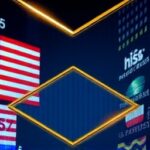In 2025, the U.S. economy stands at a precarious crossroads, propelled by an unprecedented AI boom that’s inflating stock market valuations to dizzying heights while leaving vast swaths of the workforce and traditional industries in the dust. As tech giants pour billions into artificial intelligence, the S&P 500 has surged past 6,000 points for the first time, largely on the backs of AI darlings like Nvidia and Microsoft. But economists are sounding alarms: if the AI investment frenzy fizzles, it could cascade into a sharp contraction of the U.S. economy, dragging the stock market down with it. With over 70% of recent S&P 500 gains attributed to the technology sector, the question looms large—could the end of this digital gold rush trigger a full-blown collapse?
AI Boom Powers Unprecedented S&P 500 Rally
The technology sector has been the undisputed engine of the stock market’s ascent in 2025, with AI innovations driving investor euphoria. Nvidia’s stock alone has quadrupled since the start of the year, fueled by demand for its AI chips that power everything from autonomous vehicles to generative chatbots. According to Bloomberg data, AI-related investments reached $200 billion in the first half of 2025, a 150% increase from the previous year, propelling the S&P 500 to new records.
This surge isn’t isolated to Big Tech. Smaller players in the AI ecosystem, such as startups developing machine learning algorithms for healthcare and finance, have seen their valuations skyrocket. The Nasdaq Composite, heavily weighted toward technology stocks, has outperformed the broader market by 25 percentage points year-to-date. ‘The AI gold rush is reminiscent of the dot-com era, but with tangible applications that are reshaping industries,’ says Dr. Elena Vasquez, chief economist at the Brookings Institution. Her analysis highlights how AI has contributed to a 12% rise in corporate productivity across tech firms, directly boosting earnings and stock prices.
Yet, this boom masks deeper dependencies. The S&P 500’s top 10 holdings, dominated by AI leaders, now account for nearly 35% of the index’s total weight—up from 25% just two years ago. This concentration amplifies risks: a slowdown in AI adoption could erase trillions in market cap overnight. Federal Reserve Chair Jerome Powell recently noted in a congressional testimony, ‘While innovation drives growth, overreliance on a single sector could expose the U.S. economy to asymmetric shocks.’
Divided U.S. Economy: Tech Thrives While Others Stagnate
Beneath the glittering surface of AI-fueled prosperity, the U.S. economy reveals stark divisions in 2025. The technology sector employs over 10 million workers and boasts unemployment rates below 2%, but the rest of the nation tells a different story. Manufacturing, retail, and service industries—employing 60% of the workforce—face stagnation, with GDP growth in non-tech sectors hovering at a meager 1.2% annually, per U.S. Bureau of Labor Statistics figures.
Inflation has cooled to 2.5%, but wage growth outside Silicon Valley lags at 3%, barely keeping pace with living costs. In Rust Belt states like Ohio and Pennsylvania, factory closures linked to AI automation have displaced 500,000 jobs since 2023. ‘The U.S. economy is bifurcated: AI is creating wealth for the few, but it’s hollowing out the middle class,’ warns Paul Krugman, Nobel laureate economist, in a recent New York Times op-ed. He points to rising income inequality, with the top 1% capturing 40% of AI-generated gains.
The stock market’s optimism hasn’t trickled down. Consumer confidence indices, such as the Conference Board’s measure, sit at 95—down from 110 in early 2024—reflecting fears of a recession outside the tech bubble. Real estate markets in non-coastal cities are flat, with home prices rising only 1% year-over-year, compared to 8% in tech hubs like Austin and Seattle. This disparity underscores how the AI surge is propping up the S&P 500 but failing to lift the broader U.S. economy, setting the stage for vulnerability if investments wane.
Analysts Sound Alarm on AI Hype Bubble Bursting
Wall Street’s brightest minds are increasingly wary that the AI gold rush could end abruptly, potentially devastating the S&P 500 and the U.S. economy. Goldman Sachs analysts predict a 20-30% correction in the stock market if AI spending plateaus, citing overvaluation metrics like the S&P 500’s price-to-earnings ratio of 28—well above its historical average of 16. ‘We’re in bubble territory,’ declares Jamie Dimon, CEO of JPMorgan Chase, in an interview with CNBC last month. ‘AI is transformative, but the hype has outpaced reality; a pullback could shave 5% off GDP growth.’
Supporting this view, a Deloitte survey of 500 CFOs revealed that 65% plan to cut AI budgets in 2026 if return on investment doesn’t materialize soon. Current projections show AI contributing $15.7 trillion to the global economy by 2030, but short-term hurdles like regulatory scrutiny and energy demands for data centers could stall progress. The U.S. Securities and Exchange Commission (SEC) is probing several AI firms for misleading investor claims, echoing the Enron scandals of the early 2000s.
Market volatility has already spiked, with the VIX index—the ‘fear gauge’—averaging 25 points in Q2 2025, up from 15 the prior year. If the AI boom halts, ripple effects could hit supply chains: semiconductor shortages might worsen, impacting everything from electric vehicles to consumer electronics. Economists at the IMF estimate that a 10% drop in technology sector stocks could trigger a 1.5% contraction in U.S. GDP, amplifying unemployment to 6% nationwide.
Historical Echoes: Lessons from Past Tech Bubbles
The current AI frenzy draws uncomfortable parallels to historical stock market bubbles, where unchecked enthusiasm in the technology sector led to widespread economic pain. The dot-com crash of 2000 wiped out $5 trillion in market value, sending the S&P 500 into a 49% plunge and tipping the U.S. economy into recession. Similarly, the 2008 financial crisis, though not tech-specific, showed how sector imbalances can cascade.
In 2025, AI’s role mirrors these events but on steroids. Venture capital funding for AI startups hit $100 billion last year, rivaling the peak of internet investments in the late 1990s. Yet, unlike the early web, AI’s applications are more mature—think ChatGPT’s 1 billion users or Tesla’s AI-optimized factories. Still, skeptics like Nassim Taleb, author of ‘The Black Swan,’ argue in a recent Bloomberg column that ‘AI’s black swan event—a regulatory clampdown or ethical backlash—could pop this bubble faster than anticipated.’
Looking at metrics, the S&P 500’s tech-heavy composition echoes the Nasdaq’s 2000 peak, where 80% of gains came from unprofitable dot-coms. Today, while many AI firms are profitable, their growth rates are slowing: Meta’s AI ad tech, for instance, grew ‘only’ 40% in Q1, down from 60% a year ago. These signs suggest the U.S. economy’s reliance on the stock market’s AI pillar is a house of cards, vulnerable to sentiment shifts.
Navigating the Risks: Policy Moves and Investor Strategies
As the AI gold rush shows signs of fatigue, policymakers and investors are scrambling to fortify the U.S. economy against potential fallout. The Biden administration’s proposed $50 billion AI Infrastructure Act aims to diversify investments into green tech and manufacturing, reducing overdependence on the technology sector. ‘We can’t let AI be the only story; broad-based growth is essential for the S&P 500’s stability,’ stated Treasury Secretary Janet Yellen during a Senate hearing.
For the stock market, diversification is key. Portfolio managers recommend allocating no more than 20% to AI stocks, balancing with defensive sectors like utilities and healthcare. BlackRock’s latest report advises hedging with options amid rising volatility, projecting a possible S&P 500 dip to 5,000 if AI hype cools. On the economic front, the Federal Reserve may pause rate cuts if inflation from AI-driven supply disruptions reemerges, potentially stabilizing but slowing growth.
Looking ahead, the implications are profound. If the AI boom sustains, it could usher in a new era of productivity, lifting the U.S. economy to 3% annual growth. But a sudden stop—triggered by geopolitical tensions over chip supplies or antitrust actions against AI monopolies—might force a reckoning. Investors and leaders must act decisively: fostering AI ethics guidelines, upskilling workers for the post-boom world, and monitoring the technology sector’s every move. The S&P 500’s fate, and America’s economic resilience, hangs in the balance of this digital frontier.









